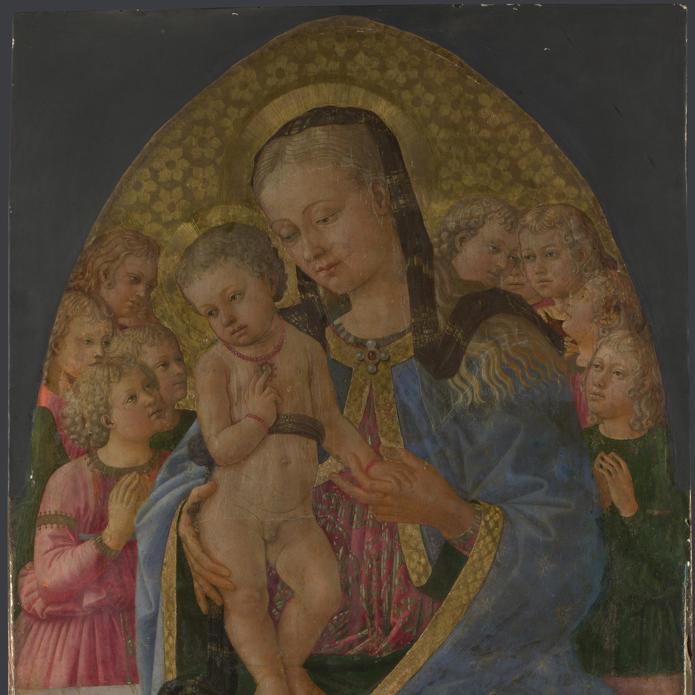Zanobi Machiavelli, 'The Virgin and Child', probably about 1470
About the work
Overview
Two angels with golden wings and jewelled diadems invite us into this painting. They sit on a step, playing a lute and a violin, looking out at us. Behind them rises the Virgin Mary, seated on a stone bench. She supports the infant Christ, who stands on her lap and raises his right hand in blessing. Ten angels are gathered behind them, some with hands clasped in devotion.
This panel is the central part of an altarpiece. The two side panels, which are also in the National Gallery’s collection, show Saint Nicholas of Tolentino and a bishop saint, and Saints Bartholomew and Monica. The presence of the latter, the mother of Saint Augustine, suggests that the altarpiece came from an Augustinian foundation. The Florentine church of S. Spirito has been suggested, but another possibility is the Tuscan hilltop town of Montepulciano, where the panels were recorded in a private collection in the early nineteenth century.
Key facts
Details
- Full title
- The Virgin and Child
- Artist
- Zanobi Machiavelli
- Artist dates
- about 1418 - 1479
- Part of the series
- Panels from an Altarpiece
- Date made
- probably about 1470
- Medium and support
- egg tempera on wood
- Dimensions
- 163.8 × 70.5 cm
- Acquisition credit
- Bought, 1857
- Inventory number
- NG586.1
- Location
- Not on display
- Collection
- Main Collection
Provenance
Additional information
Text extracted from the ‘Provenance’ section of the catalogue entry in Martin Davies, ‘National Gallery Catalogues: The Earlier Italian Schools’, London 1986; for further information, see the full catalogue entry.
Exhibition history
-
2011Devotion by Design: Italian Altarpieces before 1500The National Gallery (London)6 July 2011 - 2 October 2011
Bibliography
-
1951Davies, Martin, National Gallery Catalogues: The Earlier Italian Schools, London 1951
-
1986Davies, Martin, National Gallery Catalogues: The Earlier Italian Schools, revised edn, London 1986
-
2001
C. Baker and T. Henry, The National Gallery: Complete Illustrated Catalogue, London 2001
About this record
If you know more about this work or have spotted an error, please contact us. Please note that exhibition histories are listed from 2009 onwards. Bibliographies may not be complete; more comprehensive information is available in the National Gallery Library.
Images
About the series: Panels from an Altarpiece

Overview
These three panels once formed an altarpiece. The largest, which shows the Virgin Mary holding the Christ Child, would have appeared at its centre. Saint Nicholas of Tolentino and a bishop saint would have appeared on the left of the central image, with Saints Bartholomew and Monica on the right. The inclusion of Saint Nicholas of Tolentino, an Augustinian friar, and Saint Monica, mother of Saint Augustine, suggests that this altarpiece was made for an Augustinian foundation, perhaps the Florentine church of S. Spirito.
The panels have been linked to two others by Zanobi Machiavelli; while their compositions and gold backgrounds correspond, their shapes and sizes do not. A small panel showing a scene from the life of Saint Nicholas of Tolentino (Rijksmuseum, Amsterdam) has also been suggested as part of the ensemble.
The shape and gold background would have appeared slightly old-fashioned by around 1470, when Zanobi Machiavelli painted this altarpiece.





